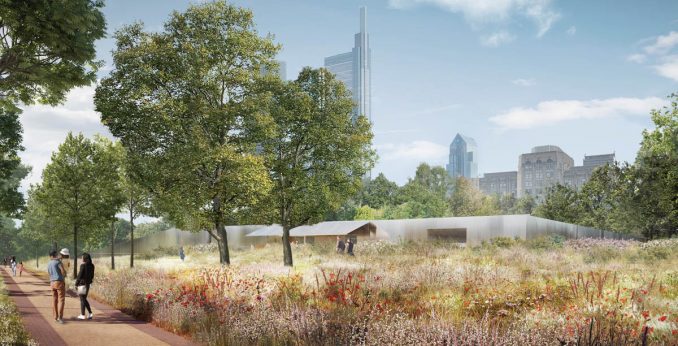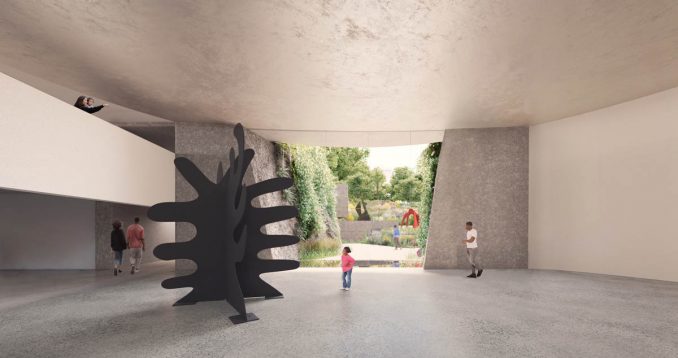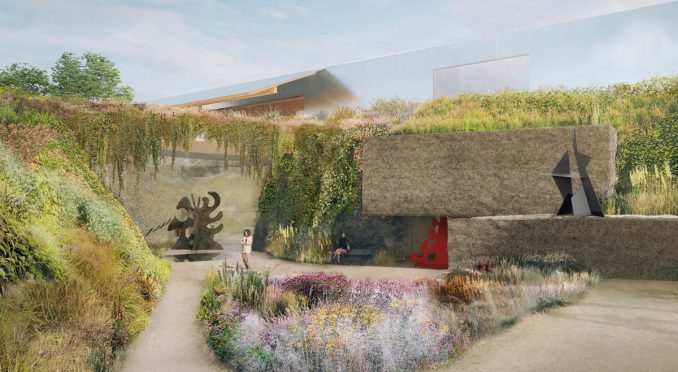Recently the design for Calder Gardens was unveiled for its new site on the Benjamin Franklin Parkway in the heart of downtown Philadelphia. Featuring a building conceived by Herzog & de Meuron and gardens by landscape designer Piet Oudolf, the project is dedicated to the art and ideas of Alexander Calder, a native Philadelphian who is considered one of the most innovative and influential artists of the 20th century.

Featuring galleries illuminated by natural light, in a structure ensconced in a flowing landscape of native and flowering species, Calder Gardens will present a rotating selection of masterworks from the Calder Foundation, New York, including mobiles, stabiles, monumental sculptures, and paintings. “The esthetic value of these objects cannot be arrived at by reasoning,” Calder wrote in 1933. “Familiarization is necessary.” Installed both indoors and outdoors, Calder’s art will be in constant dialogue with nature and the changing atmospheres of the seasons. Calder Gardens will provide the public with a singular place for contemplation and reflection, as well as abundant opportunities for learning and community building through a schedule of inclusive public programs and special events.
Crafted specifically for the presentation of Calder’s work, the landscape and architecture of Calder Gardens will unfold as a choreographed progression that moves visitors from the quotidian city context to a more contemplative realm beyond the traditional museum experience, allowing them to engage with art as a personal, real-time encounter—as the artist intended.

“This was actually an open-ended process rather than a finished concept based on a fixed program. A kind of conceptual path which made us carve out the ground rather than build forms and volumes above—we were looking for space to present Calder’s work in a new and unprecedented way,” said Jacques Herzog, founding partner with Pierre de Meuron of Herzog & de Meuron. “That space in the making eventually grew into a whole sequence of different galleries and also rather unexpected spaces, niches and gardens; such as the apse and the quasi-galleries or open plan gallery, the sunken or vestige gardens. And not only galleries in the classical sense, but every corner and angle, every stair and corridor should be offering itself up as a place to put art.”
Discreetly nestled into the landscape, Herzog & de Meuron’s almost 18,000 sq ft structure will be sheathed in softly reflective metal cladding that blurs the boundaries between architecture and the natural world—the material and the immaterial.
Departing the busy Parkway, visitors will approach the building along a path that winds through a meadow-like landscape punctuated by trees, arriving at the main entrance on the building’s north façade. Beyond the threshold, a sequence of spaces will reveal themselves below ground level as distinct volumes that will house a constantly changing display of Calder’s most acclaimed works. Large windows will wash the interiors with natural light and frame both the shifting geometries of Calder’s work and views of different gardens conceived as outdoor galleries. A Sunken Garden and Vestige Garden are visible from within the building through expansive glazing that likewise permits visitors outdoors to see into the building’s exhibition spaces. Quiet but theatrical, Herzog & de Meuron’s design has been conceived to amplify the impact of the artworks—to encourage engagement with their kinetic properties by affording visitors many different vantage points—and to catalyze discovery and reflection.

The seamless relationship between the built elements designed by Herzog & de Meuron and the gardens envisioned by Piet Oudolf is central to the philosophy of Calder Gardens. The site will be distinguished by its naturalistic four-season garden, intending to create an entirely different experience than all other cultivated, manicured gardens on the Parkway.
“I see my gardens as living sculptures where change is constant,” Oudolf said. “The site is like a canvas to work on, and each plant has a personality that must work with the others. The composition of the garden is variable and will evolve through the seasons. For Calder Gardens, the horticultural design must also serve the works of art. My hope is that people will take the time to stand still and think here, to fully experience these elements together and have an emotional reaction that stays with them long after their visit. It’s not about what you see, but what you sense.”
Calder Gardens is scheduled to open in 2024. The public can learn more about Calder Gardens online at caldergardens.org
Calder Gardens Image Credit: © Herzog & de Meuron | All artworks by Alexander Calder © 2022 Calder Foundation, New York / Artists Rights Society (ARS), New York
